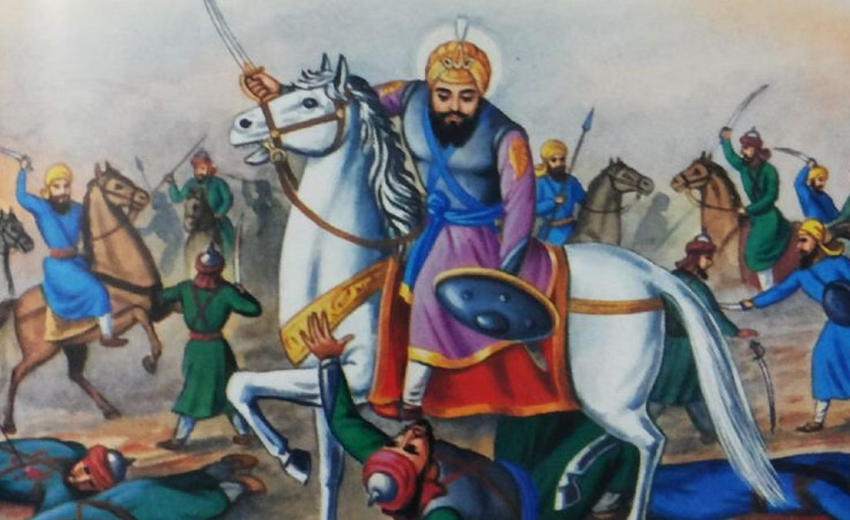Guru Hargobind Rai, also called Saccha Badshah (emperor), served as the sixth guru of Sikhs. He was born on June 19, 1595 (which is now July 5), in Guru ki Wadali, Amritsar. fOLLOWING his father Guru Arjan Dev's teachings, he became the guru on May 25, 1606. When his father was executed by Mughal authorities during Jahangir's reign, Guru Hargobind Rai was only 11 years old.
Early life
Guru Hargobind was born into a Sodhi Khatri Family, in a village 7 kilometers west of Amritsar. He was the only son of Guru Arjan, the fifth Sikh Guru. As a child, he suffered from smallpox.
According to Sikh stories, Guru Hargobind faced dangers early in his life. His uncle Prithi Chand and aunt Karmo tried to poison him twice. Once, Karmo's nurse, sent to care for Guru Hargobind, tried to poison him. She put poison around her nipple, but Guru Hargobind refused to suckle and the plan failed. Instead, the nurse fell ill from the poison herself. Another time, Prithi Chand threw a cobra at him, trying to harm him.
In another attempt to harm young Guru Hargobind, Prithi Chand and his wife sent a snake-charmer to release a snake on him. However, Guru Hargobind bravely grabbed the snake by its head and squeezed it to death. In a third try, a Brahmin, instructed by Prithi Chand and his wife, planned to mix poison with curd to feed Guru Hargobind. But Guru Hargobind knocked the curd out of the Brahmin's hands, and it fell to the floor. Unfortunately, Pista, a dog, ate some of it and died, revealing the poison. The Brahmin also succumbed to abdominal afflictions.
Guru Hargobind's education included studying religious texts with Bhai Gurdas and receiving training in swordsmanship and archery from Baba Budda. He also learned various languages, religious philosophy, astronomy, medicine, horse-riding, and administration. During his early years, Guru Hargobind immersed himself in hymns at the Harmandir Sahib complex in Amritsar.
Becoming the sixth Sikh guru
On May 25, 1606, Guru Arjan chose his son Guru Hargobind to succeed him, just five days before he passed away. He told Guru Hargobind to start a tradition of protecting Sikhs with a military force and to always have armed Sikhs around him. Shortly after, Arjan was captured, tortured, and killed on the orders of Mughal Emperor Jahangir. Guru Hargobind's succession ceremony happened on June 24, 1606. He wore two swords: one for spiritual authority and the other for temporal authority. He followed his father's advice and always had armed Sikhs around him for protection. The number fifty-two was significant in his life, and he had fifty-two armed men with him. This marked the beginning of the Sikh military tradition.
Guru Hargobind had three wives, namely, Damodari, Nanaki, and Marvahi. Sadly, two of his eldest sons from his first wife passed away during his lifetime. However, Guru Tegh Bahadur, his son from Nanaki, went on to become the ninth Sikh Guru. The Sodhis of Anandpur Sahib trace their lineage back to Baba Suraj Mal Sodhi, one of Guru Hargobind's sons.
His other pursuits
Guru Hargobind, besides being a spiritual leader, created the Taus, a musical instrument with a unique sound. He excelled in martial arts and enjoyed hunting. His legacy includes founding Kiratpur Sahib in Rupnagar district. Guru Hargobind asserted his authority at Akal Takht. Following Guru Arjan Dev's death, Guru Hargobind transformed Sikhs into fierce warriors. He urged them to stay fit and prepared for battle. Additionally, he constructed Lohgarh, a stronghold in Amritsar.
A man wore two swords, one representing Miri for temporal authority and the other representing Piri for spiritual authority. He built Akal Takht in 1606, right in front of Harmandir Sahib. At first, Akal Takht was just a platform, standing about twelve feet tall. This was a bold move, defying the Mughal rule that only the emperor could sit on an elevated platform above three feet. It's important to note that the platform of Akal Takht was slightly lower than Darbar Sahib, showing that spirituality was the foremost concern in Sikhism.
The Akal Takht marked the start of Sikh militarization. Guru Hargobind enhanced the glory of Sikhism by incorporating regal elements into its symbols of holiness, such as the umbrella (chhatar) and kalgi. He governed with the authority of a monarch, administering justice and bestowing honors and punishments accordingly.
As per Cunningham, "The genial disposition of the martial apostle led him to rejoice in the companionship of a camp, in the dangers of war, and in the excitements of the chase".
During Guru Hargobind's leadership, Sikhs developed their own unique identity separate from the Mughal government of the time. Despite focusing on military matters, Guru Hargobind also prioritized spreading the Sikh faith. He dispatched followers to distant regions for this purpose.
Guru Hargobind was not only a religious leader but also a skilled statesman, renowned for his grand court.The Guru himself was skilled in martial arts, known as shastarvidyā. He encouraged people to stay physically fit and prepared for combat. He held his own court, known as Darbar. Under his guidance, some of his devoted followers were armed and trained.The Guru’s cavalry, known as Risaldari, expanded to include three hundred horsemen and sixty musketeers.
He also maintained a stable housing eight hundred horses. Unlike his father Akbar, Jahangir was less tolerant of Sikhs, reflecting a shift in Mughal attitudes toward the Sikh community.
The Mughal emperor Jahangir didn't agree with Guru Hargobind's armed policy. He imprisoned the Guru in Gwalior fort for almost a year. The Guru went there willingly to help Jahangir with his illness. Sain Mian Mir asked Jahangir to release the Guru, but he refused to leave without the other 52 princes. Eventually, the Mughals had to let them all go. This event is celebrated as Bandi Chhorh (liberator) divas in Sikh history, coinciding with Diwali. After Jahangir, Shahjahan became the emperor, but relations soured again. During his life, the Guru fought four battles, winning each one for the Sikhs.
Passing Gurgaddi
On March 3, 1644 (Bikrami 1701), Guru Hargobind gathered his followers and appointed his son Guru Har Rai as his successor. That evening, Guru Hargobind passed away. A city called Hargobindpur was named in his honor. He gained it after defeating the Mughals.
Guru Hargobind holds a unique place in Sikh history. He introduced martial arts and weapons, and emphasized the principles of Miri and Piri, transforming the Sikh community.
*Based on an article by Sukhpal Kaur, published by Punjab News on 5th July 2012

